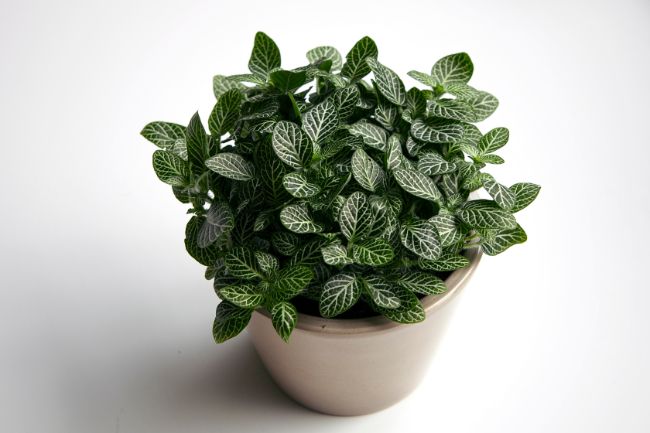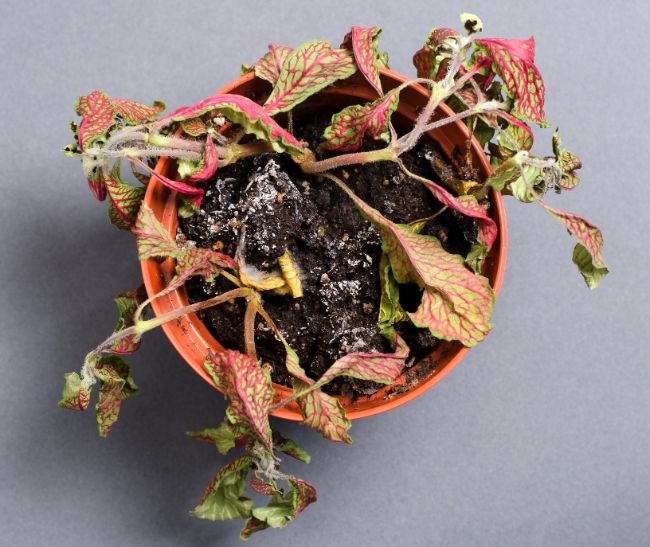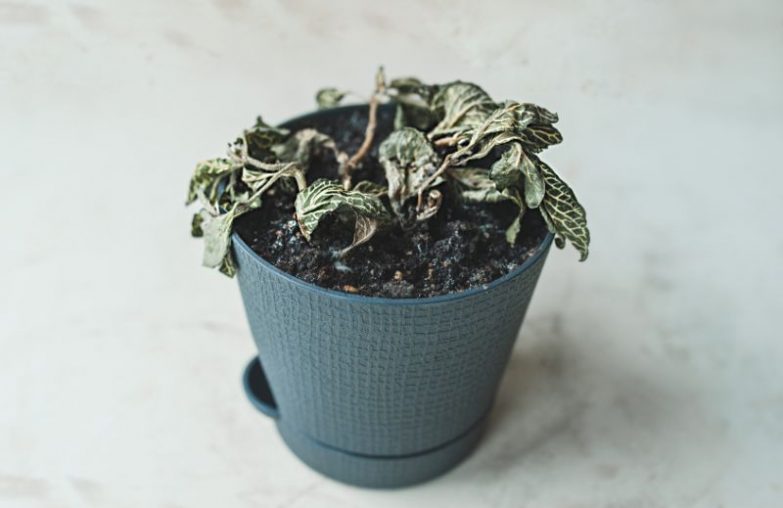Fittonia (Nerve plants) are all elegance and grace, with their striking deep-green leaves and delicately patterned veins in white, pink, or red. But don’t be fooled by their sophisticated looks, as Fittonia plants are ready to throw tantrums and start wilting at a moment’s notice! Thankfully, this article will help you find out why your Fittonia plant is dying and guide you on how to return this little beauty to perfect health.
If it looks like your Fittonia plant is dying, it is most likely due to underwatering, low humidity, or incorrect lighting. Other causes of a Nerve plant wilting include overwatering, over-fertilizing, pest problems, or potting in incorrect soil. Make sure to identify the correct cause to help you fix your plant.
7 Causes For Your Fittonia Plant Wilting And Looking Sickly
Hailing from the tropical rainforests of Peru, this stunning houseplant absolutely loves constant high humidity. It is a low-growing creeper that spreads as ground cover in the wild under the shade of tall trees. Hence, it is sensitive to direct sunlight. These attributes make the Fittonia plant a bit tricky to care for – but with proper attention, it can be a gorgeous addition to your home.
It can be really heartbreaking to witness your Fittonia wilting and drooping without knowing the reason for the plant’s distress. Often, a wilting Fittonia is a sign of the plant being thirsty. Check the soil for dryness, and if the top of the soil feels dry, give it some water, and expect to see the limp plant perking up again in a few minutes.
If this simple solution doesn’t work, then the problem lies elsewhere. It could be that the plant’s environment is not humid enough or maybe the lighting conditions are not ideal. As Fittonia plants originate from tropical rainforests, they prefer conditions that mimic their natural home. I’ve written another article to help you with general Fittonia plant care to help you get up to speed.
Listed below are some common causes of your Fittonia plant dying, wilting, or looking sickly.
Is Your Fittonia Dying Due To Underwatering?
The most common cause of a Nerve plant wilting is underwatering. In severe cases, you will notice its leaves getting crisp. The roots of this plant need constant moisture, so if you truly love your Fittonia, you have to remember to give it enough water to enable it to sustain its stunning foliage.
Tips To Fix This Problem
Keep the soil of your Fittonia plant consistently moist. Check your plant every few days and water it once the surface of the soil is just starting to dry out. Water your plant thoroughly until water drains freely from the pot. Make sure to let all excess water drain from the pot after watering.
The water requirements of your Fittonia will vary depending on the size of the plant, the size of the pot, the rate of growth, and the underlying growing conditions. It’s easy to underestimate how often your Fittonia needs to be watered in the summer when it will be growing quickly. You may need to check on your Nerve plant more frequently to prevent it from drying out during these times.
Another tip is to consider using tepid water for watering to prevent any shock to the plant. Some people report that watering with very cold water can cause their plant to struggle.
I’ve written another article covering some great tips for watering your houseplants. It’s one of the most important skills to learn to keep your houseplants thriving.
Is Your Nerve Plant Wilting Due To Overwatering?
Fittonia plants hate dry soil, but remember that too much water is not good for this plant either. While its roots love moisture, they will not appreciate sitting in water for too long. Overwatering will cause this plant’s roots to rot and its leaves will start turning yellow and limp. Long story short, lightly moist, rather than soggy soil is the way to go when it comes to Fittonia plants.
Tips To Fix This Problem
The best way to protect your Fittonia’s roots from rotting is to water it only when you notice the top layer of the soil turning dry. Yes, this plant loves moisture and humidity, but in their zeal to keep it healthy, most people end up giving it more water than the plant really needs.
Make sure to let excess water drain from the pot after watering. If your plant sits on a drip tray or in an outer decorative pot, make sure water doesn’t accumulate at the bottom, causing the roots to sit in water.
Overwatering can also be caused by overpotting your Nerve plant. If you pot your plant in a container that is too large, the large quantity of soil will remain wet for a long time after watering, increasing the risk of root rot.
If you think you may have overwatered your Fittonia plant, you can read this article on fixing overwatered plants, or this one about fixing root rot to help you get your plant back to full health.

Is Your Nerve Plant Wilting Due To Low Humidity?
If you notice the leaves of your Fittonia are quickly withering and wilting, it could be because it is not getting adequate humidity. check for leaf curling and brown tips and edges of the leaves. Fittonia plants have high humidity requirements, and humidity of less than 40% will often start to cause issues.
I like to use a digital hygrometer in my home to monitor humidity levels for my plants. If I am concerned about humidity being an issue, I leave it near my plant, and the humidity meter will record the current, as well as the low and high humidity readings. I can then adjust humidity as needed. This is the one I use.
Tips To Fix This Problem
Since Fittonia plants dry out quickly, they should be placed in a humid environment to prevent wilting. This is particularly important in winter months as central heating dries the air in our homes.
There are a number of options to increase humidty for your Fittonia plant.
- Group your plants together. The increased transpiration from your plants increases local humidity.
- Place your Fittonia on top of a tray to which you add some pebbles and water as required. Make sure the bottom of the container rests on the pebbles and is not actually touching the water. Evaporation of the water will increase humidity.
- Use a humidifier to quickly and easily increase humidity levels. They do require a little maintenance but are very effective.
- Consider planting your Fittonia in a terrarium. You could even use a mason jar to make a DIY terrarium at home. A terrarium is a great way of recreating the naturally moist rainforest environment that will ensure your Fittonia doesn’t feel home-sick.
- Read this article for more good ways to increase humidity for your houseplants.
Is Excess Light Harming Your Fittonia?
Fittonia plants tend to be quite picky about the amount of light they need. If you notice dry, shriveled leaves, and evidence of scorching on your Fittonia, it could be a sign of the plant getting too much direct sunlight causing the leaves to burn. Direct sunlight will also dry out the plant quickly and so you’ll need to water it very frequently.
This is a tropical plant that grows under the shade of canopies of trees where it gets lots of bright, indirect light. And this is exactly what the plant prefers – bright, indirect sun. It also grows well under LED or fluorescent grow lights.
Tips To Fix This Problem
The only way to fix this problem is to keep the plant in an area that does not get direct sunlight, but lots of indirect light. For example, north or east-facing windows are ideal for fittonia plants as they usually offer bright indirect light this plant needs to thrive.
But don’t make the mistake of keeping your Fittonia in a poorly lit location. If you have a colored variety and you keep it in a dark spot for too long, you might notice the plant losing its color. The colored areas will turn white, and if it is a Fittonia with green leaves and white veins, too much shade might turn the leaves almost completely green.
Is Your Fittonia Plant Dying Due To Incorrect Soil?
In order to thrive, Fittonia needs soil that retains plenty of moisture but drains well. Now soil that just contains organic matter is likely to hold a bit too much water, and this might cause the soil to become waterlogged. This condition can result in many diseases and root rot. So what you need is a proper soil mix that is well-draining so that excess water drains easily.
Tips To Fix This Problem
A soil mix that I find perfect for Fittonia plants is an equal mix of peat, coarse sand or perlite, and compost. Peat retains moisture but remains light and well aerated, coarse sand or perlite facilitates drainage and aeration, and compost provides nutrition and helps the soil retain moisture.
Although this is my preferred soil mix, almost any general-purpose houseplant potting mix will work well for Fittonia plants. Commercial mixes are usually formulated to have good moisture retention while providing reasonable drainage and aeration.
Also, make sure that your Fittonia’s container has sufficient draining holes to prevent any chances of the soil getting waterlogged.
Is Your Fittonia Plant Dying Due To Fertilizer Issues?
A Fittonia plant will also lose its shine and look sickly if you are not fertilizing it correctly. Giving too much fertilizer to this plant will cause the foliage to burn and might even prove to be fatal for it.
Lack of fertilizer rarely causes issues with Fittonia plants, as most potting mixes will provide some nutrition, and Fittonia plants do not have high fertilizer requirements.

Tips To Fix This Problem
The best time to feed your Fittonia plant is from spring to fall. During this time, it is ideal to feed your Fittonia every 3-4 weeks with a balanced houseplant fertilizer. This is the one I use for many of my houseplants, with excellent results. Err on the side of caution and dilute to half of the recommended strength to prevent any problems.
Fertilizer can build up in the soil over time, and you may start to see fertilizer salts appearing on the surface of the soil and your plant starting to look sickly. Flush the soil every few months with plenty of water to wash out excess fertilizer, or repot your plant into fresh potting soil if in any doubt.
Avoid fertilizing your Fittonia plant in the Autumn and Winter as your plant will grow much more slowly and need fewer nutrients during this time.
Are Pest Problems Harming Your Fittonia Plant?
Like most indoor plants, Fittonia are susceptible to common houseplant pests like fungus gnats, aphids, scale insects, or mealybugs. A bad infestation can easily result in your Fittonia plant dying. Fittonia plants are considered to be particularly vulnerable to aphids.
Tips To Fix This Problem
Check your plant on a regular basis for any signs of pests. check both the top and underside of the leaves, as well as the soil. If you think your plant may have pests, read this article for more info on identifying and treating them.
If you identify pests on your Fittonia, immediately isolate it from your other houseplants, to prevent the bugs spreading to other plants. In addition, if you buy a new houseplant, I would strongly advise keeping it separate from your other houseplants for 1-2 weeks to be sure no pests have hitchhiked into your home.
Last Word
If you find your Fittonia plant dying, take some time to identify the problem before trying to fix your plant. Think about watering problems first, followed by humidity and lighting issues. Think about the care and conditions your plant has been experiencing over the last few weeks, as this will greatly help you to identify the problem. Once you know the cause of your Fittonia plant dying, getting your plant back to health will be much easier.
If you’d like to understand how to keep all your houseplants healthy and fix problems before they harm your plants, check out my book, Houseplants Made Easy. I cover all aspects of houseplant care to help you grow beautiful houseplants that will thrive year after year.

